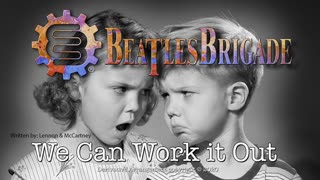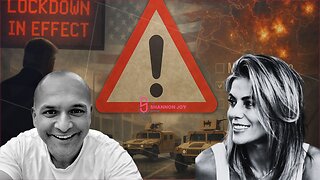Premium Only Content

The Plan to "Phase Out" Our DNA
Crimson Contagion was a joint exercise conducted from January to August 2019, in which numerous national, state and local, private and public organizations in the US participated, in order to test the capacity of the federal government and twelve states to respond to a severe pandemic of influenza originating in China.
Event 201 2019, simulates an outbreak of a novel zoonotic coronavirus transmitted from bats to pigs to people that eventually becomes efficiently transmissible from person to person, leading to a severe pandemic. The pathogen and the disease it causes are modeled largely on SARS, but it is more transmissible in the community setting by people with mild symptoms.
Operation Dark Winter was the code name for a senior-level bio-terrorist attack simulation conducted on June 22–23, 2001. It was designed to carry out a mock version of a covert and widespread smallpox attack on the United States. Tara O'Toole and Thomas Inglesby of the Johns Hopkins Center for Civilian Biodefense Strategies / Center for Strategic and International Studies, and Randy Larsen and Mark DeMier of Analytic Services were the principal designers, authors, and controllers of the Dark Winter project.
Atlantic Storm was a ministerial exercise simulating the top-level response to a bioterror incident. The simulation operated on January 14, 2005 in Washington, D.C. It was created in part to reveal the current international state of preparedness and possible political and public health issues that might evolve from such a crisis.
Clade X was a 2018 pandemic modelling exercise by Johns Hopkins University's Center for Health Security, named after the hypothetical infective agent. In the simulation, the hypothetical pandemic resulted in 900 million simulated deaths.
CRISPR (/ˈkrɪspər/) (clustered regularly interspaced short palindromic repeats) is a family of DNA sequences found in the genomes of prokaryotic organisms such as bacteria and archaea. These sequences are derived from DNA fragments of bacteriophages that had previously infected the prokaryote. They are used to detect and destroy DNA from similar bacteriophages during subsequent infections. Hence these sequences play a key role in the antiviral (i.e. anti-phage) defense system of prokaryotes
An RNA vaccine or mRNA vaccine is a type of vaccine that uses a copy of a natural chemical called messenger RNA to produce an immune response. The vaccine transfects molecules of synthetic RNA into immunity cells. Once inside the immune cells, the vaccine's RNA functions as mRNA, causing the cells to build the foreign protein that would normally be produced by a pathogen or by a cancer cell. These protein molecules stimulate an adaptive immune response which teaches the body how to identify and destroy the corresponding pathogen or cancer cells. The delivery of mRNA is achieved by a co-formulation of the molecule into lipid nanoparticles which protect the RNA strands and helps their absorption into the cells.
i7u
The Center’s SPARS Pandemic exercise narrative comprises a futuristic scenario that illustrates communication dilemmas concerning medical countermeasures (MCMs) that could plausibly emerge in the not-so-distant future. Its purpose is to prompt users, both individually and in discussion with others, to imagine the dynamic and oftentimes conflicted circumstances in which communication around emergency MCM development, distribution, and uptake takes place. While engaged with a rigorous simulated health emergency, scenario readers have the opportunity to mentally “rehearse” responses while also weighing the implications of their actions. At the same time, readers have a chance to consider what potential measures implemented in today’s environment might avert comparable communication dilemmas or classes of dilemmas in the future.
The self-guided exercise scenario for public health communicators and risk communication researchers covers a raft of themes and associated dilemmas in risk communications, rumor control, interagency message coordination and consistency, issue management, proactive and reactive media relations, cultural competency, and ethical concerns. To ensure that the scenario accounts for rapid technological innovation and exceeds the expectations of participants, the Center’s project team gleaned information from subject matter experts, historical accounts of past medical countermeasure crises, contemporary media reports, and scholarly literature in sociology, emergency preparedness, health education, and risk and crisis communication.
-
 5:43
5:43
planetpearson
4 years ago"Good King Kong Looked Out" by P.D.Q. Bach
81 -
 2:20
2:20
Beatles Brigade Band Performs the music of the Beatles
4 years ago $0.01 earnedThe Beatles Brigade - We Can Work it Out
1752 -
 7:52
7:52
Liberty Counsel
4 years agoVica Steel - "Coming Out" Announcement Video - (Facebook Source)
462 -
 2:56
2:56
stickupbeatz.com
4 years ago"Shoot It Out" Pooh Shiesty x Key Glock Type Beat 2021
49 -
 3:36
3:36
BEATLEMAN
4 years ago $0.01 earnedMY VERSION OF "MOCIN OUT" FROM BILLY JOEL
58 -
 2:46
2:46
Dan_Janes
4 years agoAudio Jam #4 AKA "Rock Out"
86 -
 25:42
25:42
IsaacButterfield
9 hours ago $0.17 earnedAmerica Is Broken
7.95K16 -

The Shannon Joy Show
3 hours ago🔥🔥False Flag Incoming? Concerns About Another Military Lockdown Under Trump Are Amplified As War Rhetoric Heats Up. With Special Guest Doc Malik🔥🔥
13.6K4 -

LumpyPotatoX2
2 hours agoSCUM v1.0 | Roleplaying Gameplay - #RumbleGaming
2.42K1 -
 LIVE
LIVE
GloryJean
4 hours agoMnK #1 Aggressive Gameplay 🖱️ 6.7 K/D
19 watching